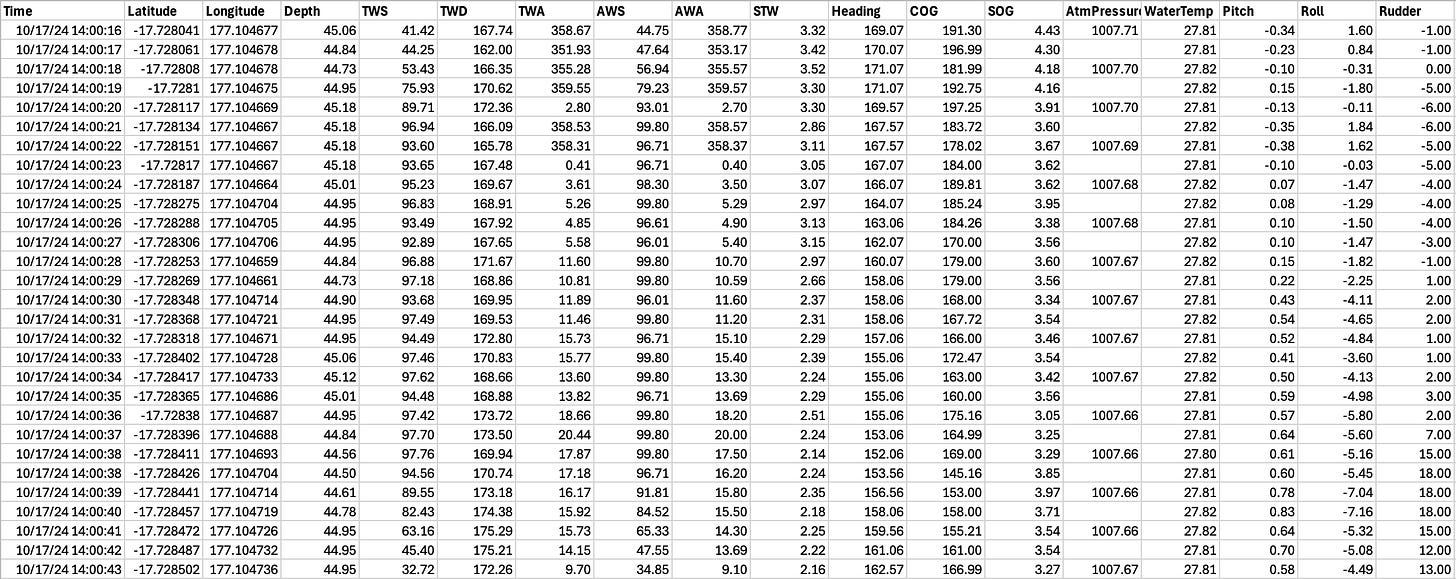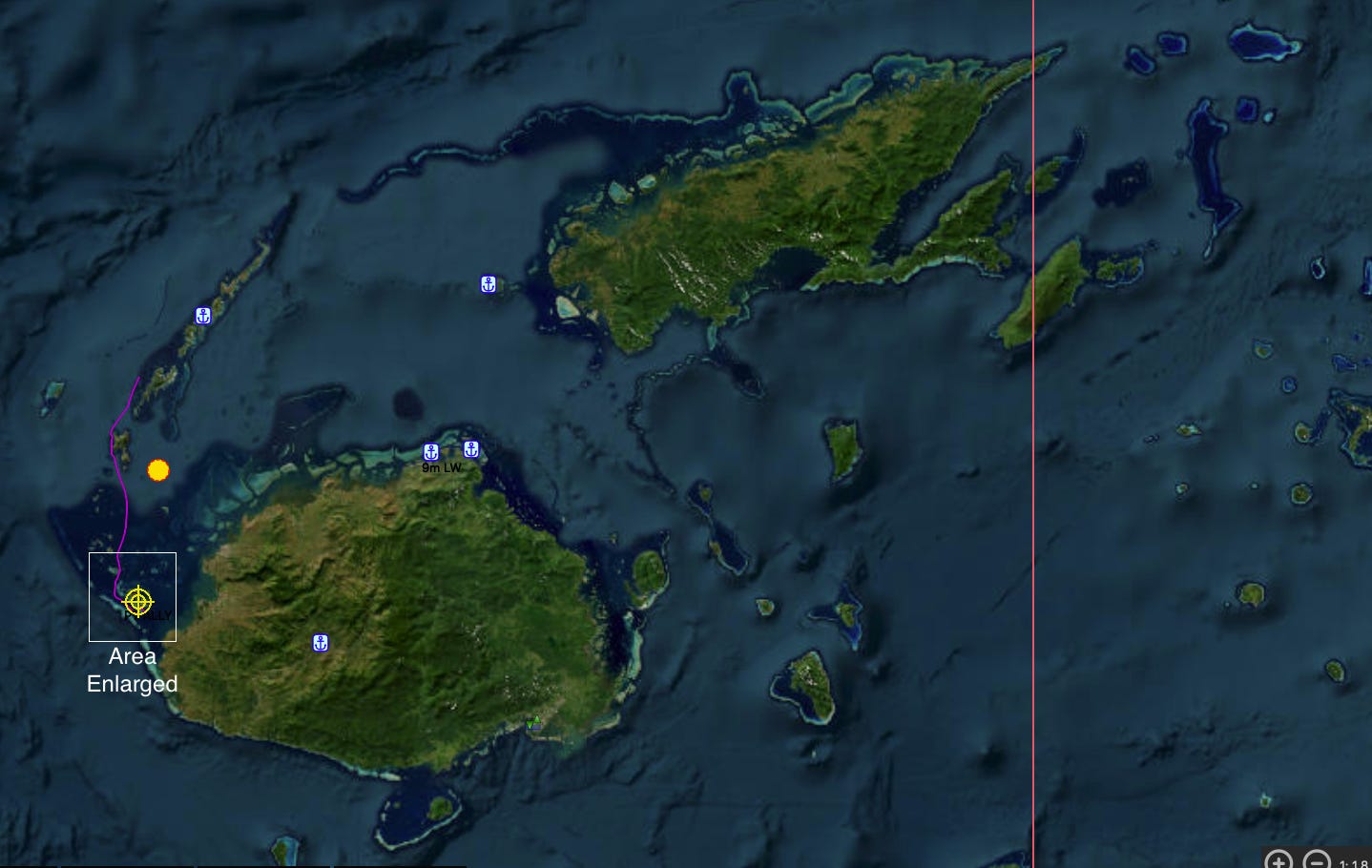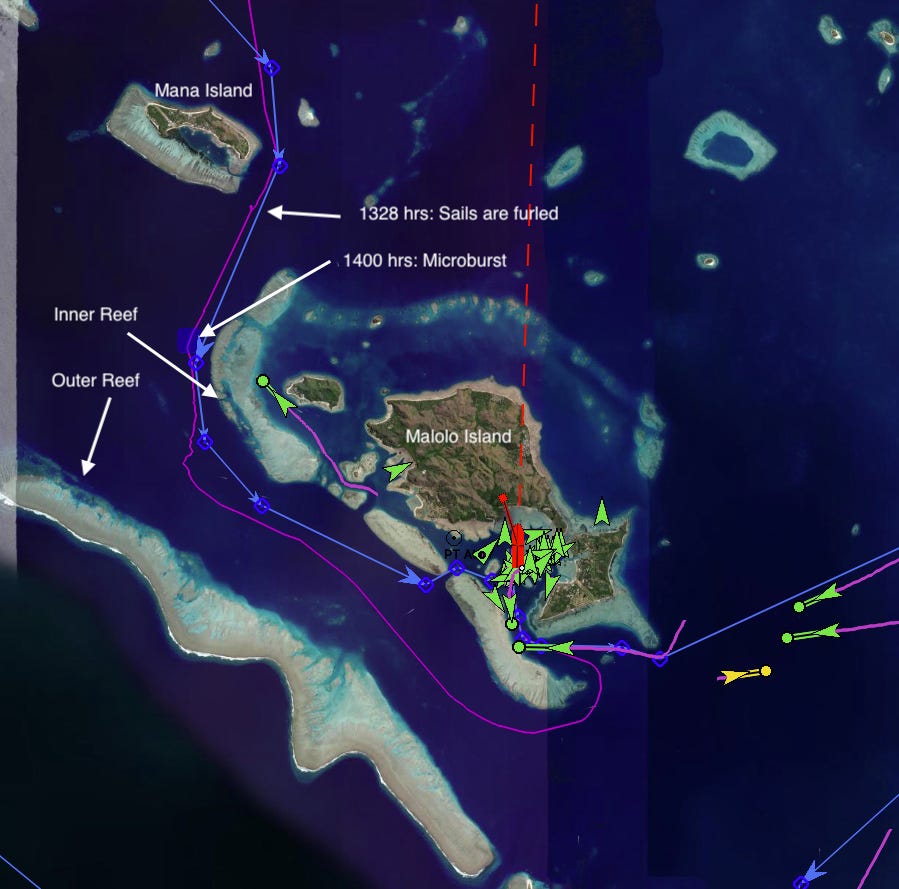This article will appear out of sequence as I have been asked by the cruising community to share a recent experience that may be of benefit to others. The next regular blog post will cover my visit to the Society Islands, and should be released in one week.
Summary: On Thursday October 17th at 1400 Fiji Time (0200 UTC), Wind River was hit with a 22 second microburst1 with true wind speeds that topped 97 knots. Fortunately and surprisingly, neither the boat nor I suffered any damage. I will explain the chronology of events leading up to and immediately following the microburst, so that others can learn from it and develop their own understanding of how to deal with similar events. All times referenced will be local Fijian time. All wind readings will be True Wind (not Apparent Wind). If you’re not a sailor, you may struggle with some of this content.
On the morning of October 17, 2024, Wind River departed Octopus Resort Cove on Waya Island at 0800 bound for Musket Cove (a southerly passage). The forecast had called for northerlies of 10-20 with a chance of showers. The planned route was 33 nautical miles and estimated time en route was 5-6 hours. The route was well known, and tracks were provided by SV Chiquita2.
After motoring south through the Waya Island’s west channel, and clearing the island’s south end, I unfurled the staysail and mainsail (reef 3). I generally don’t like full canvas out when the forecast calls for gusts, and am more conservative than most even when conditions are favorable. Slow, steady and less heel means less stress on the rig, less stress on the body, and a better chance of a safe arrival.
At 1230 hrs, winds were 10-15 from 020-040 degrees. I noticed squalls north of my position, in the distance well beyond Waya Island. I took a compass reading on them every 5 minutes and established that they were moving in a south/southwesterly direction (ie. they would pass to my west, to the boat’s starboard). I made the decision to maintain course and continue sailing.
Around 1300 hrs, with Mana Island3 to my starboard, it began to rain and visibility deteriorated to less than 5 miles. Winds were a steady 15 kts from 040 degrees. I would soon be approaching the channel to the west side of Malolo, with reefs on either side of it, and the deteriorating conditions meant one of those reefs would be a dangerous lee shore. I decided to furl the sails at 1328 hrs with winds still 10-15kts from 025 degrees. I cannot explain why I decided to furl the mainsail and the staysail and turn on the engine. Call it intuition, or -more likely- plain luck.
Visibility continued to deteriorate, perhaps down to 2 miles, and at 1346 hrs winds increased to 25-30 from 200-230 degrees, with continuous rain. I turned on my automated horn signal to indicate “Underway”. A ferry crossed ahead of me to enter Mana Island’s harbor around the same time.
From 1354-1359 winds were 30-40 kts and had backed to 180. The air had also gotten colder and visibility dropped to a few hundred meters, at best. The rain kept the seas from building, but there was spray everywhere. The autopilot began having trouble steering the boat in a straight line (its responsiveness setting was set to 3 on a scale of 9, 9 being most responsive). Fearing possible lightning that had been forecast, I put most of the portable electronics in the oven, which acts as a faraday cage and protects them from damage. I then decided to steer by hand.
At 1359, the winds momentarily spiked to between 47-69 kts from 040-070 degrees, and at 1400, the microburst hit with winds of 97 kts from 170.4 Terror aside, my concerns were:
Keeping the boat pointed into the wind and praying the bimini, solar panels and dinghy wouldn’t fly away leaving destruction in their wake.
Navigating a path that would keep me well off the reef around Malolo Island (aka the inner reef), which was a dangerous lee shore.
Ensuring the engine’s raw water cooling circuit was not taking in any air through the raw water intake (a possibility in turbulent seas), which would result in an overheat situation and engine shutdown.

From 1401-1500, winds were 25-35 kts from 160-180 degrees, and I continued to struggle with steering the boat. As the wind would catch one side of the bow, Wind River would fall off 50-60 degrees, and 15+ degrees of rudder input were required to bring the boat back into the wind. The boat would then fall off to the other side and the cycle would repeat. I was focused on gaining sea room from that inner reef.
By 1500, winds were 20-30 kts from 160-180 degrees, and abating; the situation became more manageable. I was able to reengage the autopilot (on a higher responsiveness setting) and go below to put on my foulies. I then returned to the cockpit and motored past my intended entry to Musket Cove and onwards to the southern entrance, buying some time for the conditions to improve.
At 1645 hrs I entered Malolo Island’s south passage and proceeded to the Musket Cove anchorage, setting down the hook at 1707 hrs and settling in for some much needed rest.
In examining this event, a few reflections are worth sharing:
I am surprised my bimini didn’t fly away, and quite puzzled. I was pointed into the wind, which probably helped.
Wind River didn’t heel much during the microburst. I shudder to think of the knockdown, torn sails and possible dismasting that could have resulted had I not made the fortunate decision to furl the sails 30 minutes prior to the event.
As a singlehander, this event consumed all my energy. I was not wearing my foulies (it’s warm in Fiji), and it took one hour after the microburst before I could step away from the helm and get suited up.
When the microburst struck, I was hemmed in by reefs to my east, south and north, and one further away to the west. I was trying to keep the boat pointed into a southerly wind. If other trouble had emerged (failed engine, rudder failure, dismasting, water ingress, you name it) I would have had to anchor in depths of 40 meters, which would have been impossible. Plenty of reefs dot these waters, and another track may or may not have provided better outcomes.
Autopilots lose responsiveness in these conditions. If you’re someone like me whose autopilot is their primary helmsman, you’ll need to practice hand steering for a few hours a day -preferably in adverse conditions- so your helming skills stay sharp. I’m incorporating hand steering into my routine going forward.
I have a rule that port lights and portholes must be closed on passage, along with companionway boards if the weather is inclement. It makes for a stuffy boat, yes, but it is (mostly) inviolable. Had the windows been open and the boat suffered a knockdown, the situation would have been potentially catastrophic.
I am keen on “putting the boat away” in an organized fashion. You will not find loose equipment or untidy lines on my decks or in my cockpit whether at anchor or on passage. Lines are coiled neatly and placed over their respective winches. I feel this paid off by eliminating additional failure possibilities (example: line falls in the water and wraps around a prop, disabling the engine).
I always think of the possible failures, minute by minute: proximity to reefs, what to do if rig or engine fails, what to do if struck by lightning. I then review the mental checklist of the actions I would take in that moment to deal with those particular failure possibilities. It’s a game of sorts; the more I review possible failure scenarios, the better prepared I feel.
For an explanation of a microburst: https://www.weather.gov/bmx/outreach_microbursts
My gratitude to Ding on SV Chiquita. He has sailed within Fijian waters for the past 17 years and his tracks across the islands are a treasure.
Mana Island is immediately northwest of Malolo Island
Unfortunately, my cockpit camera was offline (a fact I didn’t realize until later), and I have nothing visual to share here; just imagine a wide-eyed look of terror.





Thank you for sharing this Raffi. Very good information and a sobering experience. We were underway motoring near Denerau at the same time this happened too you and had white-out conditions with driving rain; thankfully no microburst though! Your comment about 'putting the boat away" hit a real chord with me as I am often guilty of not doing this, particularly on short hops, so it is something I will work to improve! - it I have also re-shared it with a meteorologist friend at Gulf Harbour Radio who is also a cruiser as I'm sure he will be interested. Cheers
Good you doused the sails when you did! As sailors, we should always listen to our instinctive, gut feelings - 'better safe than sorry' and a (small) genoa can always be deployed in a hurry in case of engine failure in a crisis. Glad no damage was sustained and the nearby reefs were avoided - imagine you slept well once you'd anchored! (PS I always keep a foulie jacket hanging within easy reach from cockpit when on passage - hypothermia can set in surprisingly quickly if you're wet in strong wind.)